Microeconomics Assignment: Intertemporal Choice and Expected Utility
VerifiedAdded on 2020/06/05
|8
|1224
|50
Homework Assignment
AI Summary
This assignment solution delves into the microeconomic concept of intertemporal choice, examining how individuals make consumption and saving decisions across different time periods. The solution analyzes the impact of interest rate changes on borrowing and saving behavior, illustrating these effects with diagrams and calculations. It further explores the expected utility framework, using a house insurance example to demonstrate how individuals make decisions under uncertainty based on their risk aversion. The assignment also discusses factors beyond the intertemporal choice model, such as population structure and social security, that influence household saving patterns. References to relevant academic literature are included to support the analysis.
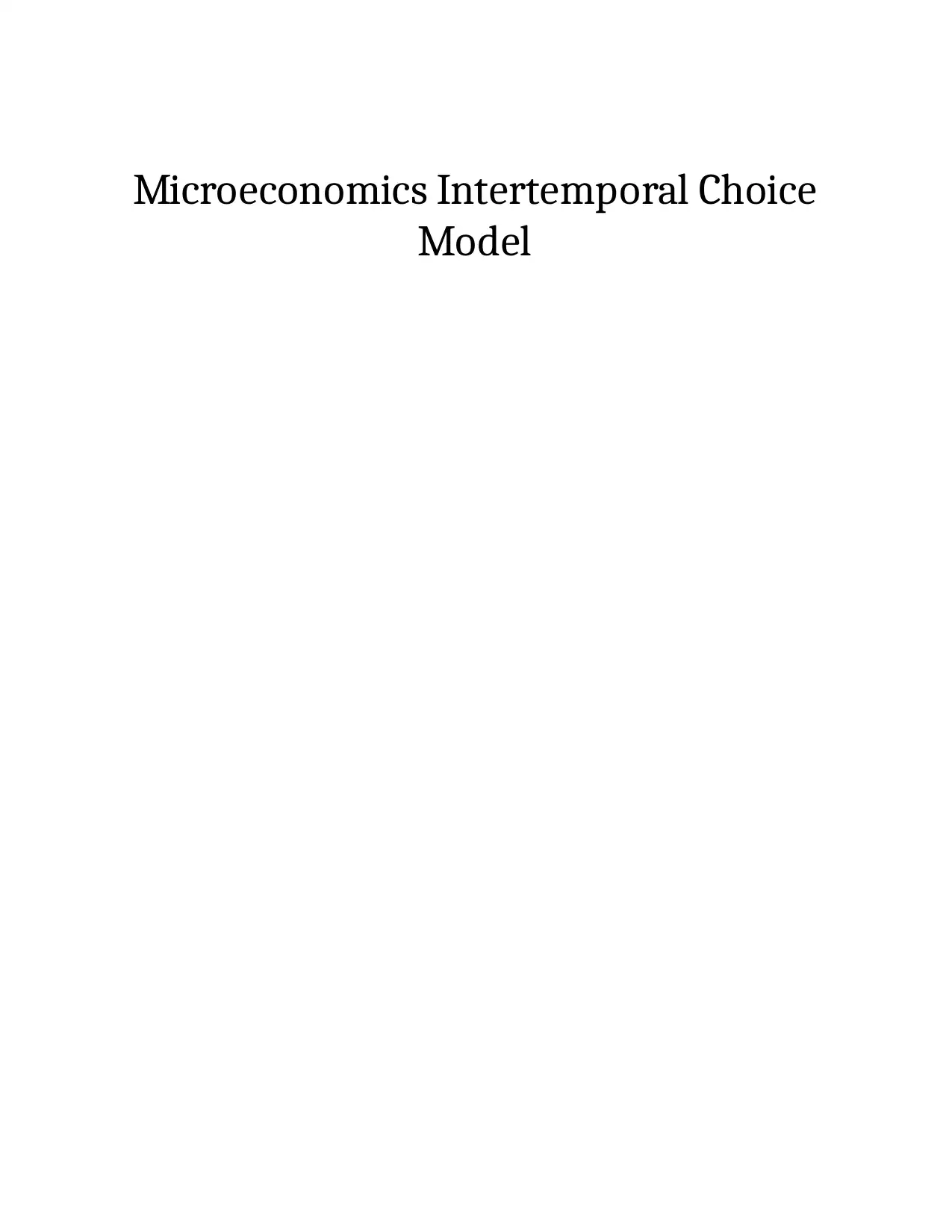
Microeconomics Intertemporal Choice
Model
Model
Paraphrase This Document
Need a fresh take? Get an instant paraphrase of this document with our AI Paraphraser
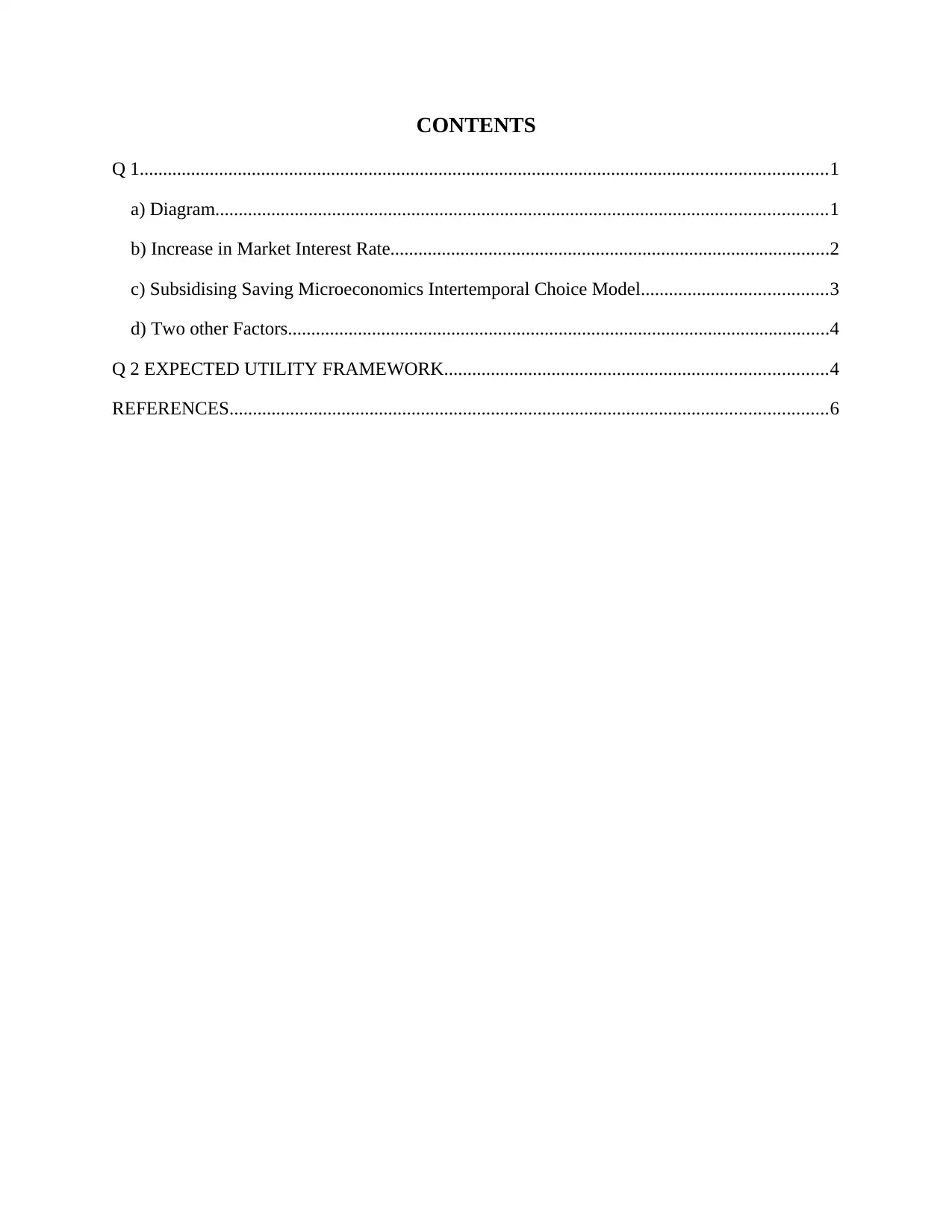
CONTENTS
Q 1...................................................................................................................................................1
a) Diagram...................................................................................................................................1
b) Increase in Market Interest Rate..............................................................................................2
c) Subsidising Saving Microeconomics Intertemporal Choice Model........................................3
d) Two other Factors....................................................................................................................4
Q 2 EXPECTED UTILITY FRAMEWORK..................................................................................4
REFERENCES................................................................................................................................6
Q 1...................................................................................................................................................1
a) Diagram...................................................................................................................................1
b) Increase in Market Interest Rate..............................................................................................2
c) Subsidising Saving Microeconomics Intertemporal Choice Model........................................3
d) Two other Factors....................................................................................................................4
Q 2 EXPECTED UTILITY FRAMEWORK..................................................................................4
REFERENCES................................................................................................................................6
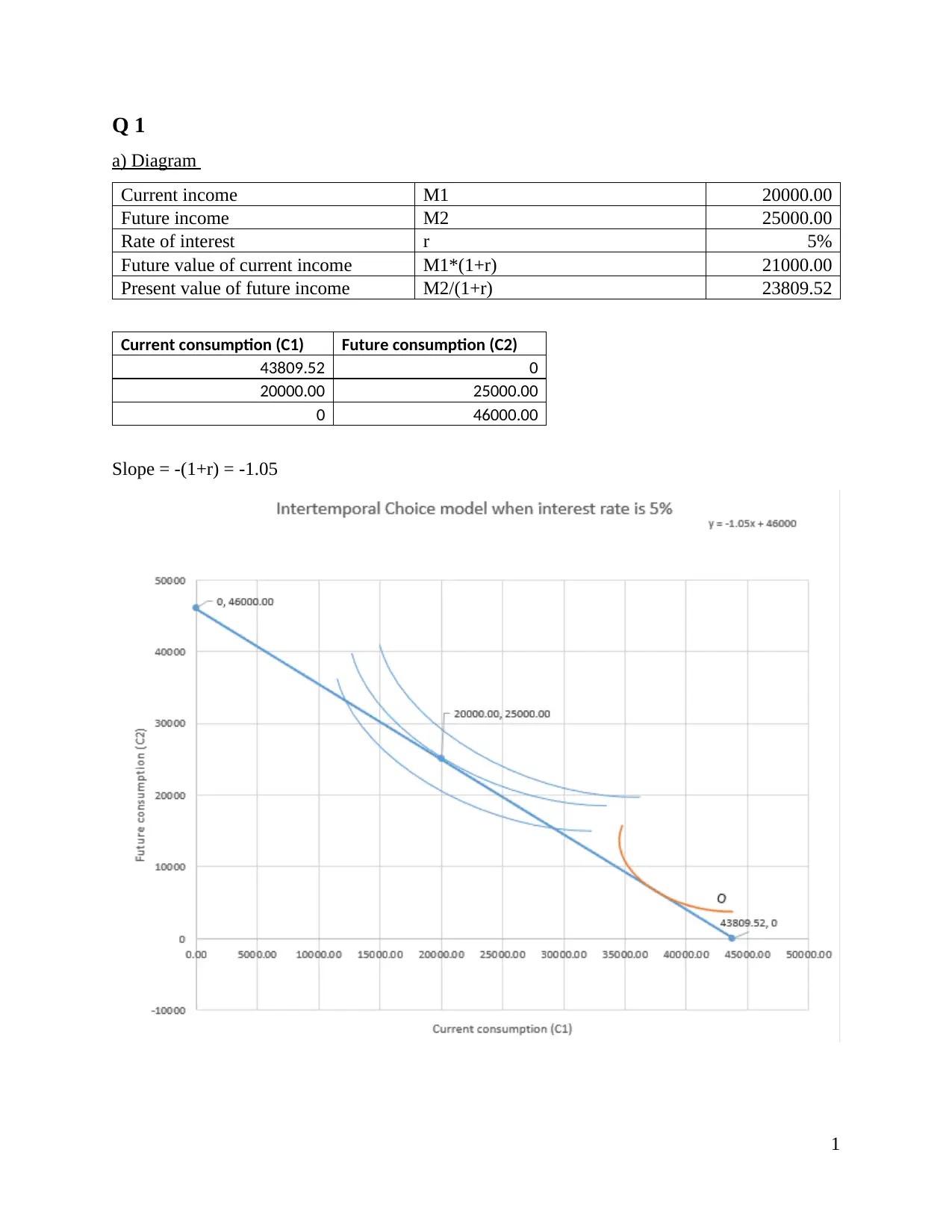
Q 1
a) Diagram
Current income M1 20000.00
Future income M2 25000.00
Rate of interest r 5%
Future value of current income M1*(1+r) 21000.00
Present value of future income M2/(1+r) 23809.52
Current consumption (C1) Future consumption (C2)
43809.52 0
20000.00 25000.00
0 46000.00
Slope = -(1+r) = -1.05
1
a) Diagram
Current income M1 20000.00
Future income M2 25000.00
Rate of interest r 5%
Future value of current income M1*(1+r) 21000.00
Present value of future income M2/(1+r) 23809.52
Current consumption (C1) Future consumption (C2)
43809.52 0
20000.00 25000.00
0 46000.00
Slope = -(1+r) = -1.05
1
⊘ This is a preview!⊘
Do you want full access?
Subscribe today to unlock all pages.

Trusted by 1+ million students worldwide
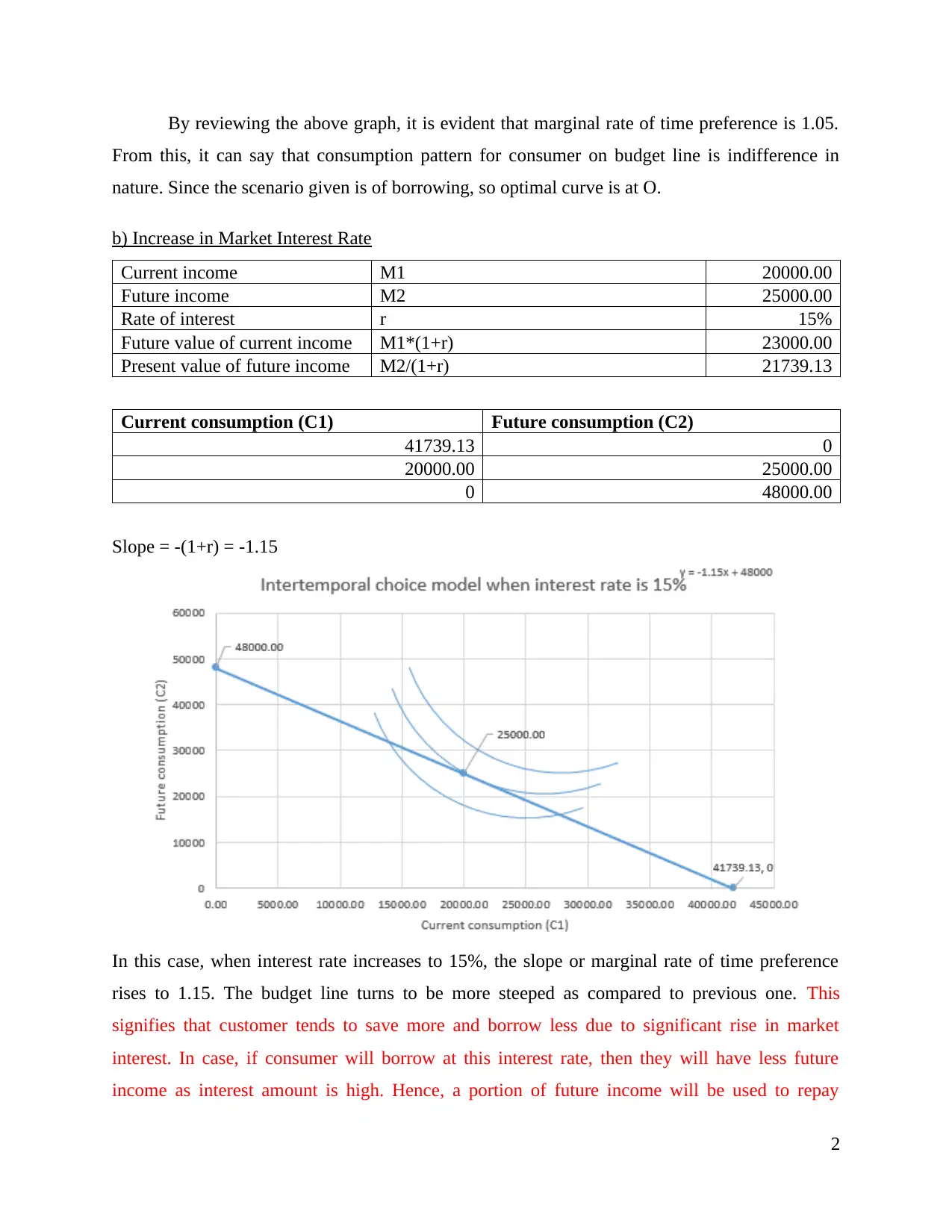
By reviewing the above graph, it is evident that marginal rate of time preference is 1.05.
From this, it can say that consumption pattern for consumer on budget line is indifference in
nature. Since the scenario given is of borrowing, so optimal curve is at O.
b) Increase in Market Interest Rate
Current income M1 20000.00
Future income M2 25000.00
Rate of interest r 15%
Future value of current income M1*(1+r) 23000.00
Present value of future income M2/(1+r) 21739.13
Current consumption (C1) Future consumption (C2)
41739.13 0
20000.00 25000.00
0 48000.00
Slope = -(1+r) = -1.15
In this case, when interest rate increases to 15%, the slope or marginal rate of time preference
rises to 1.15. The budget line turns to be more steeped as compared to previous one. This
signifies that customer tends to save more and borrow less due to significant rise in market
interest. In case, if consumer will borrow at this interest rate, then they will have less future
income as interest amount is high. Hence, a portion of future income will be used to repay
2
From this, it can say that consumption pattern for consumer on budget line is indifference in
nature. Since the scenario given is of borrowing, so optimal curve is at O.
b) Increase in Market Interest Rate
Current income M1 20000.00
Future income M2 25000.00
Rate of interest r 15%
Future value of current income M1*(1+r) 23000.00
Present value of future income M2/(1+r) 21739.13
Current consumption (C1) Future consumption (C2)
41739.13 0
20000.00 25000.00
0 48000.00
Slope = -(1+r) = -1.15
In this case, when interest rate increases to 15%, the slope or marginal rate of time preference
rises to 1.15. The budget line turns to be more steeped as compared to previous one. This
signifies that customer tends to save more and borrow less due to significant rise in market
interest. In case, if consumer will borrow at this interest rate, then they will have less future
income as interest amount is high. Hence, a portion of future income will be used to repay
2
Paraphrase This Document
Need a fresh take? Get an instant paraphrase of this document with our AI Paraphraser
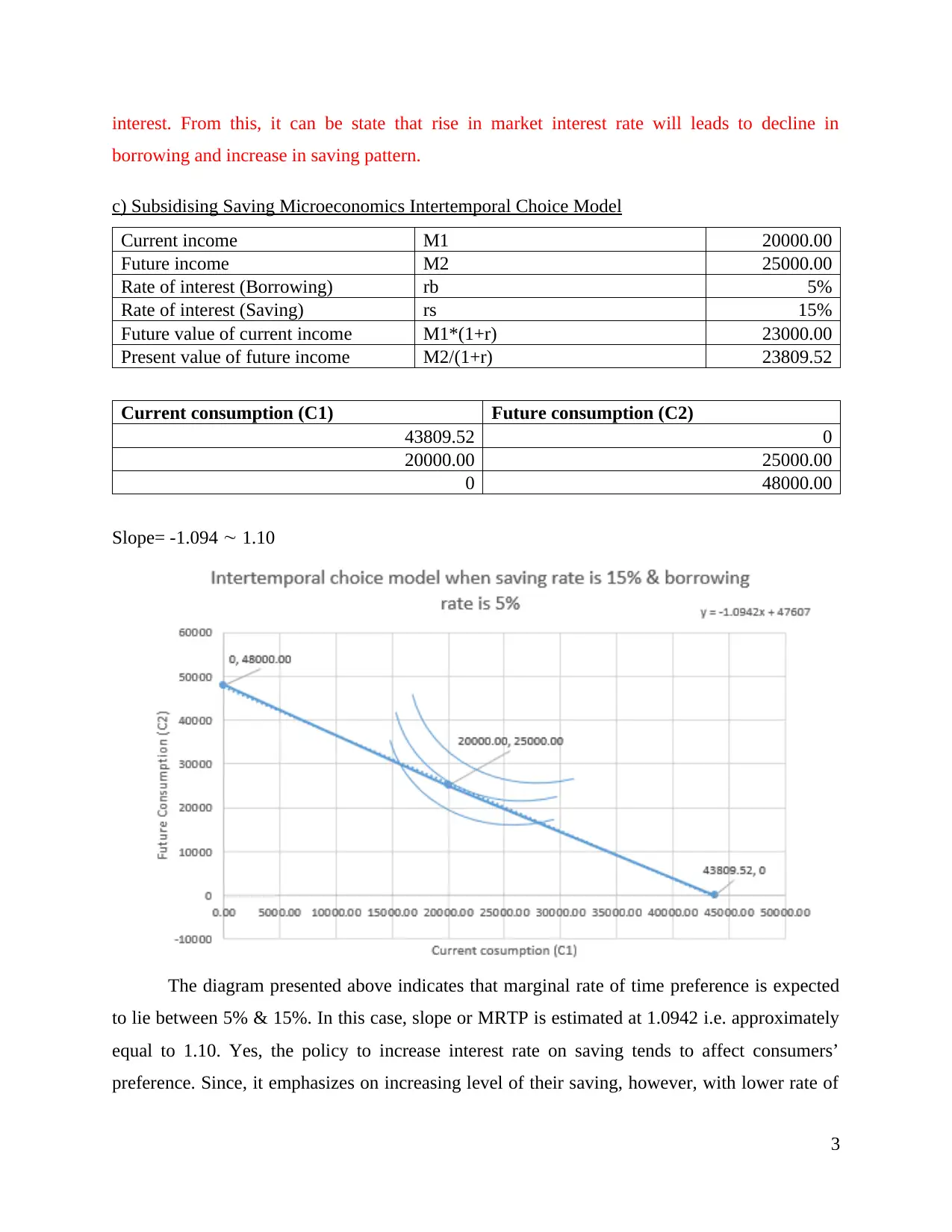
interest. From this, it can be state that rise in market interest rate will leads to decline in
borrowing and increase in saving pattern.
c) Subsidising Saving Microeconomics Intertemporal Choice Model
Current income M1 20000.00
Future income M2 25000.00
Rate of interest (Borrowing) rb 5%
Rate of interest (Saving) rs 15%
Future value of current income M1*(1+r) 23000.00
Present value of future income M2/(1+r) 23809.52
Current consumption (C1) Future consumption (C2)
43809.52 0
20000.00 25000.00
0 48000.00
Slope= -1.094 1.10
The diagram presented above indicates that marginal rate of time preference is expected
to lie between 5% & 15%. In this case, slope or MRTP is estimated at 1.0942 i.e. approximately
equal to 1.10. Yes, the policy to increase interest rate on saving tends to affect consumers’
preference. Since, it emphasizes on increasing level of their saving, however, with lower rate of
3
borrowing and increase in saving pattern.
c) Subsidising Saving Microeconomics Intertemporal Choice Model
Current income M1 20000.00
Future income M2 25000.00
Rate of interest (Borrowing) rb 5%
Rate of interest (Saving) rs 15%
Future value of current income M1*(1+r) 23000.00
Present value of future income M2/(1+r) 23809.52
Current consumption (C1) Future consumption (C2)
43809.52 0
20000.00 25000.00
0 48000.00
Slope= -1.094 1.10
The diagram presented above indicates that marginal rate of time preference is expected
to lie between 5% & 15%. In this case, slope or MRTP is estimated at 1.0942 i.e. approximately
equal to 1.10. Yes, the policy to increase interest rate on saving tends to affect consumers’
preference. Since, it emphasizes on increasing level of their saving, however, with lower rate of
3
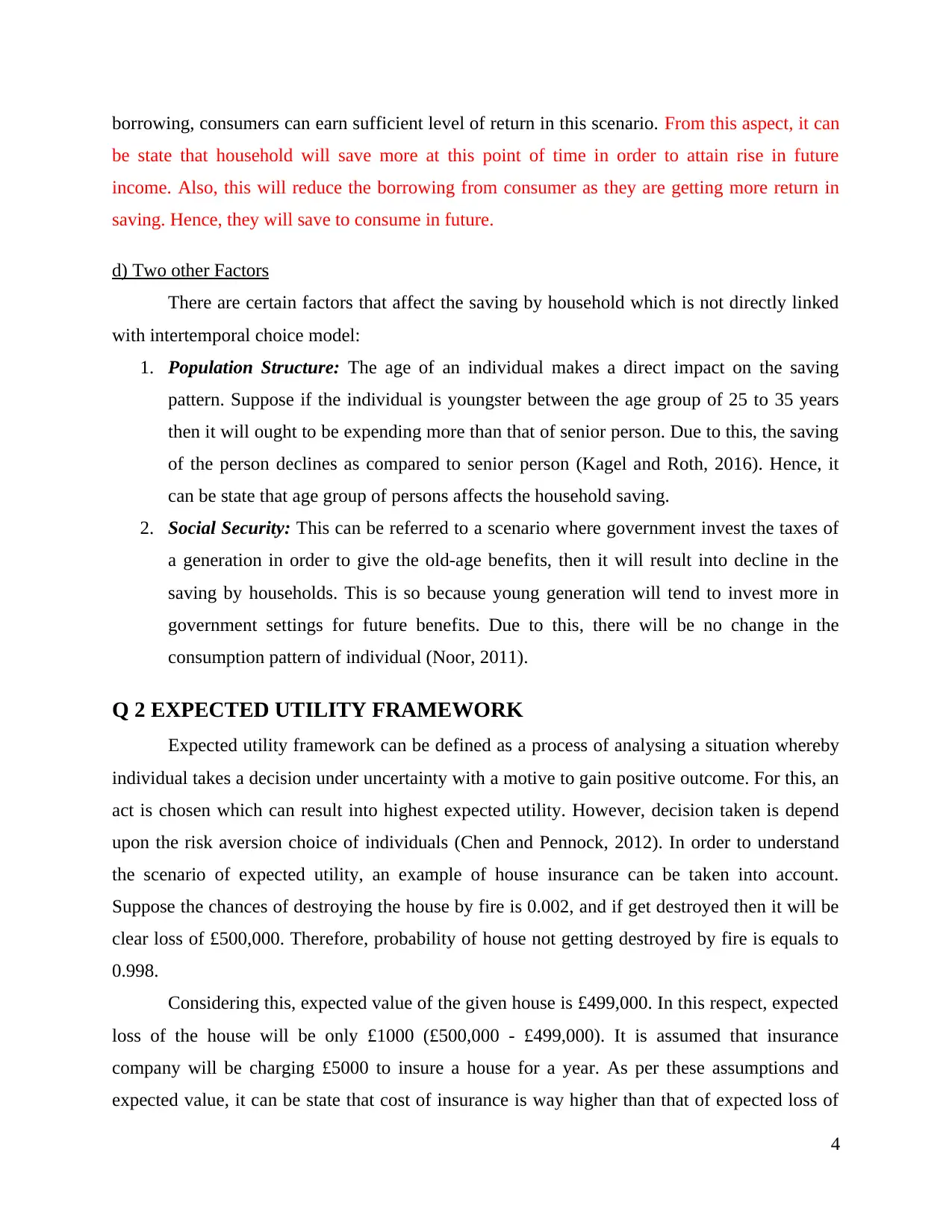
borrowing, consumers can earn sufficient level of return in this scenario. From this aspect, it can
be state that household will save more at this point of time in order to attain rise in future
income. Also, this will reduce the borrowing from consumer as they are getting more return in
saving. Hence, they will save to consume in future.
d) Two other Factors
There are certain factors that affect the saving by household which is not directly linked
with intertemporal choice model:
1. Population Structure: The age of an individual makes a direct impact on the saving
pattern. Suppose if the individual is youngster between the age group of 25 to 35 years
then it will ought to be expending more than that of senior person. Due to this, the saving
of the person declines as compared to senior person (Kagel and Roth, 2016). Hence, it
can be state that age group of persons affects the household saving.
2. Social Security: This can be referred to a scenario where government invest the taxes of
a generation in order to give the old-age benefits, then it will result into decline in the
saving by households. This is so because young generation will tend to invest more in
government settings for future benefits. Due to this, there will be no change in the
consumption pattern of individual (Noor, 2011).
Q 2 EXPECTED UTILITY FRAMEWORK
Expected utility framework can be defined as a process of analysing a situation whereby
individual takes a decision under uncertainty with a motive to gain positive outcome. For this, an
act is chosen which can result into highest expected utility. However, decision taken is depend
upon the risk aversion choice of individuals (Chen and Pennock, 2012). In order to understand
the scenario of expected utility, an example of house insurance can be taken into account.
Suppose the chances of destroying the house by fire is 0.002, and if get destroyed then it will be
clear loss of £500,000. Therefore, probability of house not getting destroyed by fire is equals to
0.998.
Considering this, expected value of the given house is £499,000. In this respect, expected
loss of the house will be only £1000 (£500,000 - £499,000). It is assumed that insurance
company will be charging £5000 to insure a house for a year. As per these assumptions and
expected value, it can be state that cost of insurance is way higher than that of expected loss of
4
be state that household will save more at this point of time in order to attain rise in future
income. Also, this will reduce the borrowing from consumer as they are getting more return in
saving. Hence, they will save to consume in future.
d) Two other Factors
There are certain factors that affect the saving by household which is not directly linked
with intertemporal choice model:
1. Population Structure: The age of an individual makes a direct impact on the saving
pattern. Suppose if the individual is youngster between the age group of 25 to 35 years
then it will ought to be expending more than that of senior person. Due to this, the saving
of the person declines as compared to senior person (Kagel and Roth, 2016). Hence, it
can be state that age group of persons affects the household saving.
2. Social Security: This can be referred to a scenario where government invest the taxes of
a generation in order to give the old-age benefits, then it will result into decline in the
saving by households. This is so because young generation will tend to invest more in
government settings for future benefits. Due to this, there will be no change in the
consumption pattern of individual (Noor, 2011).
Q 2 EXPECTED UTILITY FRAMEWORK
Expected utility framework can be defined as a process of analysing a situation whereby
individual takes a decision under uncertainty with a motive to gain positive outcome. For this, an
act is chosen which can result into highest expected utility. However, decision taken is depend
upon the risk aversion choice of individuals (Chen and Pennock, 2012). In order to understand
the scenario of expected utility, an example of house insurance can be taken into account.
Suppose the chances of destroying the house by fire is 0.002, and if get destroyed then it will be
clear loss of £500,000. Therefore, probability of house not getting destroyed by fire is equals to
0.998.
Considering this, expected value of the given house is £499,000. In this respect, expected
loss of the house will be only £1000 (£500,000 - £499,000). It is assumed that insurance
company will be charging £5000 to insure a house for a year. As per these assumptions and
expected value, it can be state that cost of insurance is way higher than that of expected loss of
4
⊘ This is a preview!⊘
Do you want full access?
Subscribe today to unlock all pages.

Trusted by 1+ million students worldwide
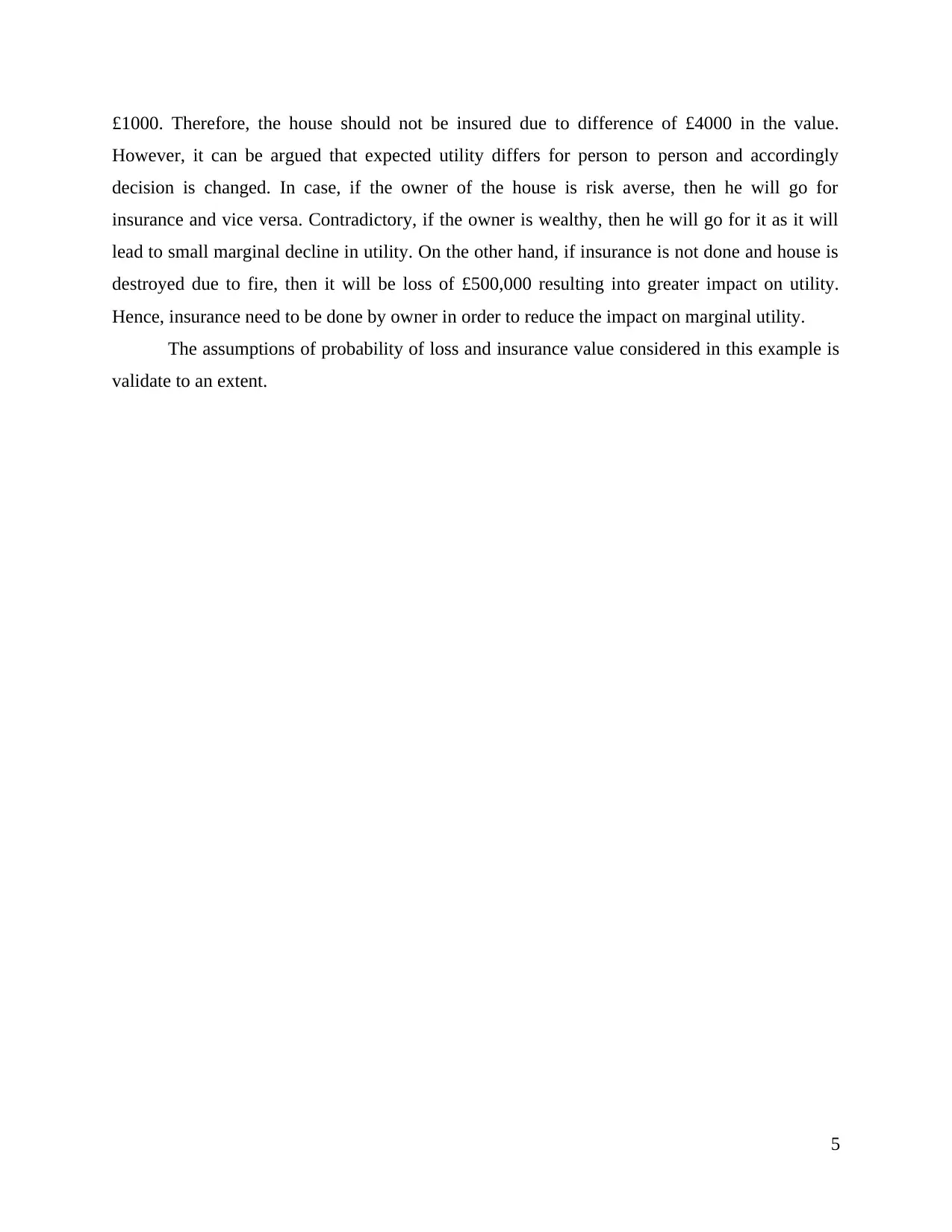
£1000. Therefore, the house should not be insured due to difference of £4000 in the value.
However, it can be argued that expected utility differs for person to person and accordingly
decision is changed. In case, if the owner of the house is risk averse, then he will go for
insurance and vice versa. Contradictory, if the owner is wealthy, then he will go for it as it will
lead to small marginal decline in utility. On the other hand, if insurance is not done and house is
destroyed due to fire, then it will be loss of £500,000 resulting into greater impact on utility.
Hence, insurance need to be done by owner in order to reduce the impact on marginal utility.
The assumptions of probability of loss and insurance value considered in this example is
validate to an extent.
5
However, it can be argued that expected utility differs for person to person and accordingly
decision is changed. In case, if the owner of the house is risk averse, then he will go for
insurance and vice versa. Contradictory, if the owner is wealthy, then he will go for it as it will
lead to small marginal decline in utility. On the other hand, if insurance is not done and house is
destroyed due to fire, then it will be loss of £500,000 resulting into greater impact on utility.
Hence, insurance need to be done by owner in order to reduce the impact on marginal utility.
The assumptions of probability of loss and insurance value considered in this example is
validate to an extent.
5
Paraphrase This Document
Need a fresh take? Get an instant paraphrase of this document with our AI Paraphraser
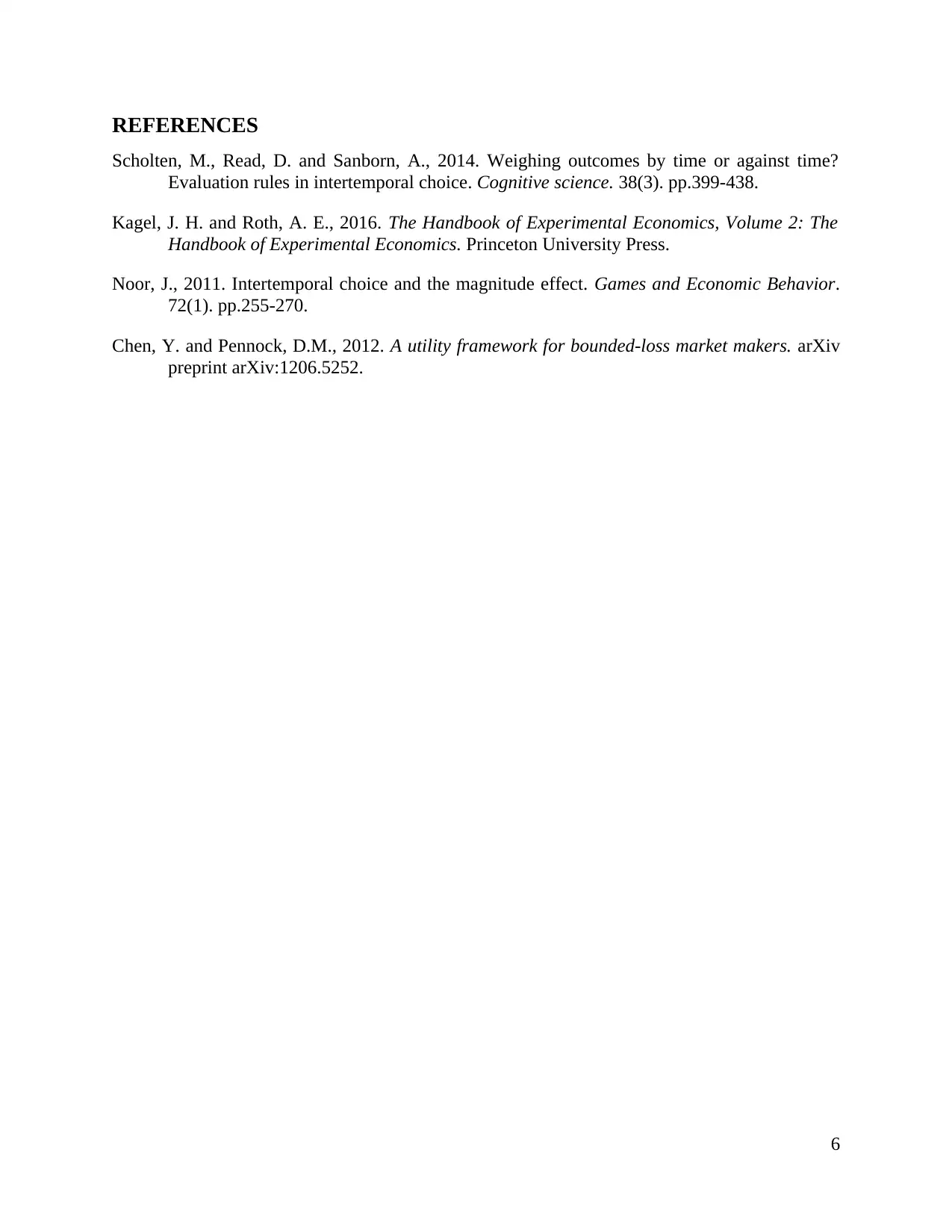
REFERENCES
Scholten, M., Read, D. and Sanborn, A., 2014. Weighing outcomes by time or against time?
Evaluation rules in intertemporal choice. Cognitive science. 38(3). pp.399-438.
Kagel, J. H. and Roth, A. E., 2016. The Handbook of Experimental Economics, Volume 2: The
Handbook of Experimental Economics. Princeton University Press.
Noor, J., 2011. Intertemporal choice and the magnitude effect. Games and Economic Behavior.
72(1). pp.255-270.
Chen, Y. and Pennock, D.M., 2012. A utility framework for bounded-loss market makers. arXiv
preprint arXiv:1206.5252.
6
Scholten, M., Read, D. and Sanborn, A., 2014. Weighing outcomes by time or against time?
Evaluation rules in intertemporal choice. Cognitive science. 38(3). pp.399-438.
Kagel, J. H. and Roth, A. E., 2016. The Handbook of Experimental Economics, Volume 2: The
Handbook of Experimental Economics. Princeton University Press.
Noor, J., 2011. Intertemporal choice and the magnitude effect. Games and Economic Behavior.
72(1). pp.255-270.
Chen, Y. and Pennock, D.M., 2012. A utility framework for bounded-loss market makers. arXiv
preprint arXiv:1206.5252.
6
1 out of 8
Your All-in-One AI-Powered Toolkit for Academic Success.
+13062052269
info@desklib.com
Available 24*7 on WhatsApp / Email
![[object Object]](/_next/static/media/star-bottom.7253800d.svg)
Unlock your academic potential
Copyright © 2020–2025 A2Z Services. All Rights Reserved. Developed and managed by ZUCOL.

